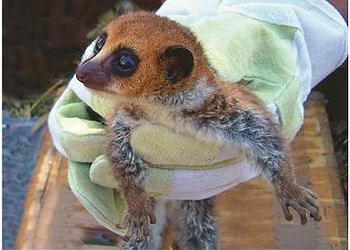
MAINZ, Germany, July 30, 2013 (ENS) – Drenched with rain and working in the dense forests of southern Madagascar, researchers have identified a new species of dwarf lemur previously unknown to science.
The island nation of Madagascar harbors a unique biodiversity that evolved due to its long-lasting isolation from other land masses. Lemurs, a subgroup of primates, are among the most prominent representatives of the island’s unique animals. They are found almost exclusively on Madagascar.
Due to extensive field research over the past decades, numerous previously unknown lemur species have been discovered, but dwarf lemurs have received relatively little attention to date, and the diversity within this genus is still not well known.

Researchers of the universities of Mainz and Antananarivo have now identified a previously unknown species of dwarf lemur, based on fieldwork in southern Madagascar and laboratory analyses.
“Together with Malagasy scientists, we have been studying the diversity of lemurs for several years now,” said Dr. Andreas Hapke of the Institute of Anthropology at Johannes Gutenberg University Mainz, JGU.
“It is only now that we were able to determine that some of the animals examined represent a previously unknown species,” he said.
The newly described Lavasoa Dwarf Lemur, Cheirogaleus lavasoensis, inhabits only three isolated forest fragments in the extreme south of Madagascar.
The exact population size is unknown, but preliminary estimates indicate there are fewer than 50 individuals remaining.
“The Lavasoa Dwarf Lemur is thus rare and extremely endangered,” said Dr. Hapke.
The lifestyle of dwarf lemurs makes them extremely difficult to study as these nocturnal forest dwellers often remain in the upper parts of the forest canopy. They hibernate for several months during the austral winter.
Their main period of activity is the rainy season, when the forests they inhabit are virtually inaccessible to scientists. Still, the researchers were able to capture a total of 51 dwarf lemurs in live traps at nine locations for this study. They took minute tissue samples before releasing the animals back into the wild.
The tissue samples were subjected to molecular-genetic analyses at the Institute of Anthropology at Mainz University. The data generated through the process were then compared with data already published by other research groups.
“The new data from southern Madagascar enabled us to significantly enlarge existing datasets,” explained Dana Thiele of the JGU Institute of Anthropology.
“We then used extensive data analyses to examine the genetic diversity in two closely related lemur genera, the mouse lemurs (Microcebus) and the dwarf lemurs (Cheirogaleus). The comparison showed that the species diversity of dwarf lemurs is greater than previously thought,” said Thiele.
Dr. Hapke and Refaly Ernest, working as a local field assistant for the project, discovered the first Lavasoa dwarf lemurs during a field study in Madagascar in 2001.
Because few genetic data from other parts of the island were available for comparison at that time, the animals were initially assigned to an already known species, Cheirogaleus crossleyi. Only now is it possible to determine that the Lavasoa Dwarf Lemur is a distinct species of its own.
The findings of the research project are published in the current issue of the journal “Molecular Phylogenetics and Evolution.”
Copyright Environment News Service (ENS) 2013. All rights reserved.
© 2013, Environment News Service. All rights reserved. Content may be quoted only with proper attribution and a direct link to the original article. Full reproduction is prohibited.
